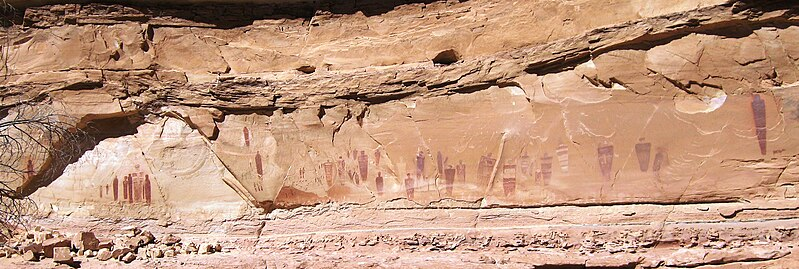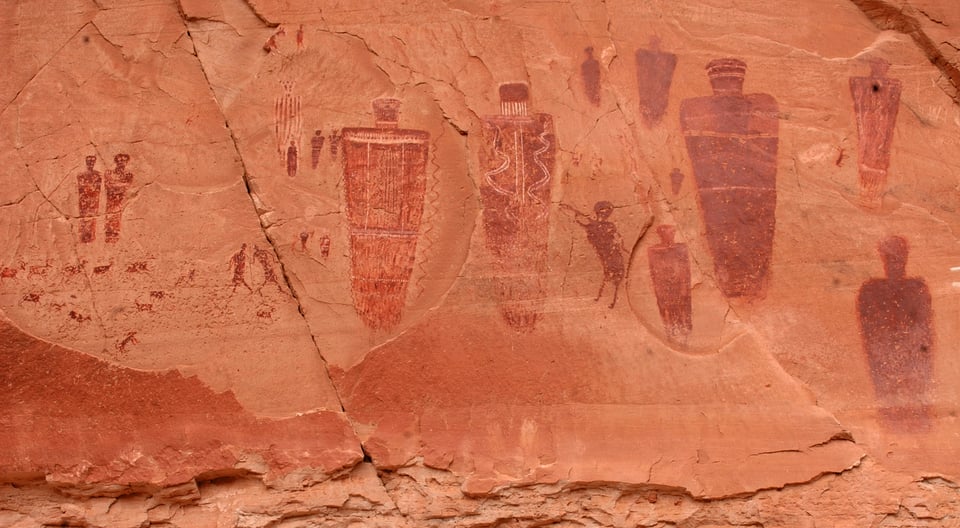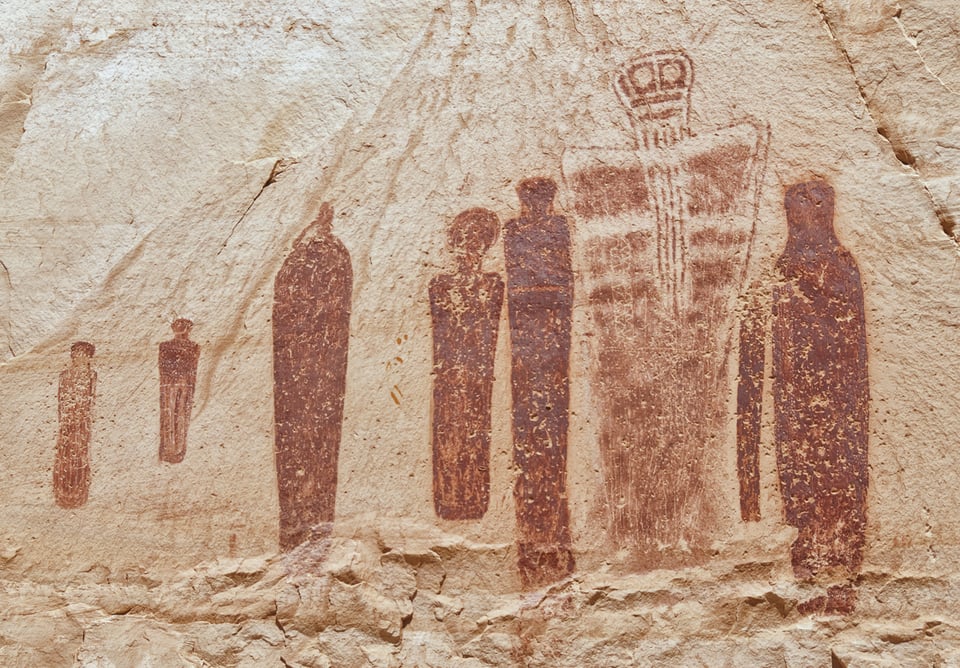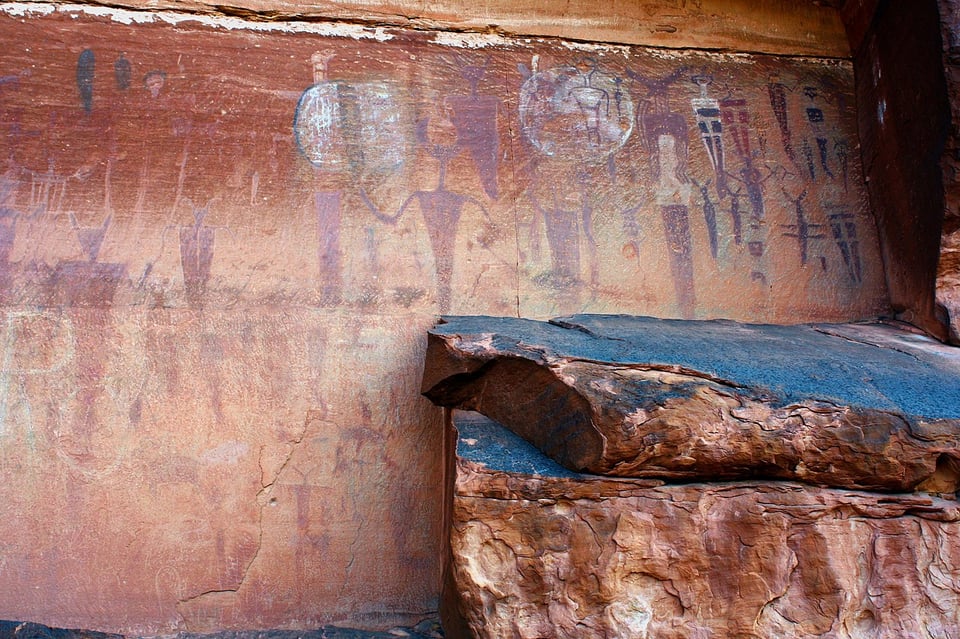A Long Time Ago... #6
Hello there.
Welcome to the sixth of these posts exploring art, fiction and history. Every other Sunday I share some insights into my two major passions - Star Wars and history, or specifically, ancient art.
Art as a means of representation, observation and meaning, has survived tens of thousands of years, expressed now in a mesmerising multitude of ways. I'm fascinated by its origins, and a particular subgenre of art known as the Star Wars franchise.
At the moment, I’m expressing and sharing this fascination by taking you through my timeline-ordered shelves of Star Wars books, as well as the ancient art sites that inspire(d) my writing.
In A Galaxy Far, Far Away…

Now we’re up to the Original Trilogy - hopefully a time period you’ll all know (and love). Above are the books I have that take place just before or in the same year as Episode IV: A New Hope and go up to a little after Episode V: The Empire Strikes Back. In real life and in universe, there’s a three year gap between those two films. First, though, are three books related to the standalone film Rogue One.
Guardians of the Whills is a YA novel by Greg Rucka that provides such a deep look at two characters from Rogue One, the blind monk-like Chirrut Imwe, and his not-so-monk-like gruff massive blaster-wielding partner Baze Malbus. It’s set just before the film, when the Empire has come to Jedha and the temple that the two once guarded is no longer functioning. They also meet Saw Gerrera, a character first introduced in The Clone Wars, then seen in live action as an older character in Rogue One and in subsequent books and TV. He sets up the main problem faced by these guardians - honour what they have left, or fight back?
Fun fact: Whills was an early name for the Force, and also an omniscient narrator that George Lucas eventually dropped from any Star Wars. The original story was all meant to be told from a Journal of the Whills, hence ‘A Long Time Ago…’
Rebel Rising by Beth Revis is, like Catalyst before it, a perfect companion to Rogue One. The frame story is protagonist Jyn Erso’s time in an Imperial labour camp/prison, but the novel really shows her journey from a girl who’s just lost her parents to a rebel under Saw Gerrera. It’s a YA story of growing up, but also full of the harsh realities of Gerrera’s guerrilla ways of fighting a war. As well as being a fantastic story of Jyn’s journey with many familiar and original characters, it also perfectly fills the gap between the prologue section and main events of Rogue One, bridging from Catalyst to our next book.
The Rogue One: A Star Wars Story Novelisation is another expanded edition-type adaptation, by Alexander Freed, potentially one of my favourite Star Wars authors. His Alphabet Squadron trilogy (we’ll get to that soon!) showcases how he can juggle the journeys of a whole cast of different characters, and that’s exactly what he does with the ensemble of the film. Rogue One is the callsign of the small group of rebels who go on a rogue mission to retrieve the Death Star plans used to successfully destroy the battle station in the first ever Star Wars film. The film is about much more than schematics though - give it a watch if you haven’t already!
Star Wars: From a Certain Point of View is, on the surface, a novelisation of A New Hope. It’s also, on the surface, a collection of 40 short stories to commemorate 40 years since the first film. Really, its brilliance is in the way that those short stories manage to tell the whole story, chronologically with hindsight on the whole Star Wars universe, with each story standing alone in uniqueness of voice, subject matter, length and with the unreliability of so many narrators. They assembled a stellar crew of established Star Wars authors, first timers, celebrities and experts who’d never written fiction in this form before.
It’s a testament to what was then 40 years of stories. If there’s one book I’d recommend getting out of this entire shelf, it might actually be this one. You’ll see the classic film in previously unknown depth, through the prismatic minds of 40 creatives, and the fresh eyes of 40 background characters. Particular favourites of mine are the first story, Raymus, by Gary Whitta, that links the end of Rogue One directly to the start of A New Hope, or Cavan Scott’s exploration of Obi-Wan’s life flashing through his eyes in his final moments.
You may be put off if I told you that Battlefront II: Inferno Squad is a video game tie-in. But that’d be foolish. Christie Golden captures the characters perfectly from the story missions of Battlefront II, but this prequel book explores the origins of the titular commando unit Inferno Squad, giving us the best look inside the minds of Imperial soldiers, especially in the wake of the Death Star’s destruction. It also serves as a continuation of Rogue One with Inferno Squad tasked to infiltrate the survivors of Saw Gerrera’s rebel cell.
Heir to the Jedi by Kevin Hearne follows Luke in the aftermath of his Death Star victory as he first finds his place in the rebellion, and first experiments with his connection to the Force and the history of the Jedi. It’s the oldest canon novel, cleverly reworked as the last in a series of the old Legends continuity to instead be a stand alone work fitting in with all the new stuff (its title is an homage to the first book in the old continuity, Heir to the Empire). Unusually for Star Wars books, its told in first person, which was initially quite a leap, but then I really enjoyed getting into Luke Skywalker’s head - I picture the book as a story he’s retelling one day to some other rebel or maybe a Jedi student in the future.
Doctor Aphra by Sarah Kuhn is the script of an audio drama that adapts Kieron Gillen’s run of Darth Vader, 25 issues that started in 2015, though it was 2020 by the time this story came out. The main difference between the versions beside the obvious is that Kuhn’s version is Aphra’s narration of events. Through her eyes now we get the important beats from the comic run set between the first two Star Wars films made - Vader’s quest to redeem himself in the eyes of the Emperor after losing the Death Star, but perhaps more importantly his discovery that the rebel behind it shares his original surname…
Doctor Aphra is perhaps the most well-known fan favourite character to spawn from Star Wars comics. An ‘archaeologist’ in the vein of Indiana Jones, she helped Vader in those 25 issues before going off on her own comic run which Gillen also began. That went on for 40+ issues, then was relaunched in 2020 for another 40. When I met Kieron last year, it was a shame to hear how he wasn’t contacted when his work was adapted, but that’s all part of the work-for-hire comics world unfortunately.
A Luke & Leia Adventure is the third of Cavan Scott’s Choose Your Destiny books that I still need to read. I’m confident I’ll like it, especially if it’ll weave into tight timeline of events between films. It’s also part of the Flight of the Falcon line of stories, so when I have all of those to read, I’ll be interested to see how the Skywalker twins find themselves with that ship.
So You Want to Be a Jedi? is another younger readers book I have yet to read, part of a trilogy of titles novelising the Original Trilogy in a more traditional way. It might be the closest to a Journal of the Whills as one can get, as flipping through I noticed it’s retold in second person, and with interlude Jedi lesson sections. In a way, it is like a guide written by a knowledgeable Force person for someone from our galaxy to understand and learn about important events.
The Empire Strikes Back: From a Certain Point of View is just as good as the first 40 years/40 short stories collections, if not better. My copy is also one of my prized possessions since it’s signed by a number of authors that I met at Celebration last year. I have read this more recently, so perhaps the stories stick with me more. Although there are a lot set on the snowy planet Hoth, I prefer them to the many cantina stories in the first anthology.
There are standouts like a story from the point of view of the giant space slug that eats the Falcon by Catherine M. Valente, or one from the point of view of the medical droid that attaches Luke’s new hand by Lydia Kang. It also holds a special place now that I know some of these authors much better. It has both Brittany N William’s and Jim Zub’s only Star Wars work. Both of those writers have helped me immensely with advice and support they provide online. And then there’s Amy Ratcliffe’s first piece of fiction! And now she has a novel, Thrill Ride, coming next year - and I’ve beta read her upcoming MG urban fantasy.
Battlefront: Twilight Company is the last for this fortnight. Alexander Freed once again (though he wrote this first) does what he does best with character, but this time he came up with a brand new set of them, and a completely brand new story within the playable maps for the game Battlefront. So already he does a fantastic job adding a plot that moves between these arbitrary locations. Take it a step further with complicated new characters, and all the ins and outs of actually being in a large scale rebel army, and you get this book. It follows Twilight Company over a long stretch of war, from before A New Hope ’till after Empire Strikes Back, tying in to that film so satisfyingly.
Next time (due to gaps in my collection - the Return of the Jedi: From a Certain Point of View would come next, as well as the need to insert the direct adaptations of A New Hope and Return of the Jedi, and a junior Chewbacca-focused story) the stories will move beyond the Original Trilogy.
In Moab, Utah, United States of America…
These fascinating painted (known there as pictographs) and etched (known as petrogylphs) figures that I’ll share today aren’t really a specific site but a series of panels in the desert closest to Moab, canyons that have been marked by many indigenous cultures across the centuries.
What drew me to these sites was the incredible art style, almost alien looking beings. The more I looked into it, the more geometric depictions of burial shrouds and headdresses took over and yet there are fascinating potentially mythological figures that can’t be explained by artistic license.
Horseshoe Canyon Great Gallery

This art comes from the Archaic Period, predating later named groups who also added their art like the Fremont or Ancestral Puebloan peoples. The Great Gallery was aptly named as it does show off some of the best art from the hunter gatherers that existed here between 400 and 1100 CE.

The big figures are life size, some 7 feet tall and the panel is 61 metres long. I was just enamoured by the forms of and the patterns on these figures, like some floating versions of the alien robot from The Day the Earth Stood Still. Of course these figures are not any proof of extra-terrestrials, but are perhaps ancestors of some form. But for my story…
The thing seems to have no arms or legs, just a flat-shouldered downwards facing cone shape, a monolith of dark patterned alien cloth. Its head is similarly conical, with the wider part at the banded top, like some robot... or the outline of a wrapped human figure.

Above is the famous ‘Holy Ghost’ panel, with a figure that really is special, ethereal. I find the surrounding filled in guys much more spooky! Another quote from me last year:
They vary in form, some with more rounded heads, or more rounded bases where feet could be at the ends of where legs could be. Some are slimmer, some are wider, some have ever-so-faintly-visible lighter patches to their patterning, like milky-white glows of an extra-terrestrial stone, or constellations depicting the forms of various ancient animals.
Courthouse Wash

Some of these figures are also up to 5 feet. This site’s higher up in a little overhang of sorts on the other side of Moab, if memory serves, 35 miles from the Great Gallery.
There are figures similar in style, as you can see, but generally more triangular and with spindly limbs and necks, with more antennae-like heads. Some do look more like insects. My favourite is the figure in the centre of the above image, with a crescent-shaped head. They appear anthropomorphic but are probably stylised headdresses. The two big white shapes are thought to represent shields from a later culture.
I cut out a bit of spoilery talk, but here’s one of the omniscient paragraphs I put to break up the action in the short story inspired by these artworks in their figurative forms (in both senses of the word?).
They are luminous beings. Glowing-new forms of sanctified life. These beings, climbed to the highest high they were born by, want to be among the stars, or moons in their own right, reflections of the light that birthed them, heavenly beacons. Born of etched symbols, etching symbolic lives. These beings, on the border of human and arthropod and dead, want to ascend. Some can hover; some are bound by their envisioned limbs, but they are a tribe that will stay together. … Wraith-men. Celestial-time will be their moth-flame-compass. They will wander like bored gods, insectoid figures from a dream world migrating in a tired reality...
I was in a certain zone when I wrote that bit.
Other nearby artwork
Couldn’t think of a better title for this little subsection. Loyal subscribers to this newsletter might remember that in March I attended a seminar from the Journal of Skyscape Archaeology about the nearby petroglyphs. The talk provided me with a fantastic map of all the sites, but also so much more information about etched marks in the vicinity, marked at certain signpost points and also as solstice markers.
I wrote notes at the time mentioning a certain solstice line where the sun comes past a boulder and hits a carved deer across the eyeline. There’s another instance of a pecked oval with rays coming out from it like a rising sun. As well as the painted dead, the sun also meant a lot to these people like it did all over the world, whether the most ancient paintings or stone circles or even now.
The main thinking from the webinar was that every aspect of the landscape was sacred, and the etched art was at meeting places in the landscape, visible spots for groups to observe the solstice, compared to the more inner world of the painted art, imagery that is much more subjective I suppose.
I also couldn’t finish this newsletter without mentioning perhaps my favourite named bit of rock art around the world: Intestine Man. Here’s a video of the site, as there weren’t any great photos I could find to use - it contains many photos of etchings and ends with Mr. Intestine. His site is further north from Moab. (Pause at 0:55 for the best view.)
There’s some varying theories about this art. I like to believe one I heard that it is some sort of rejuvenation deity. The intestines are obviously more of a snake with green highlights, and maybe the people saw snakes as rejuvenators, shedding skins to start anew.
…a metamorphic union, like caterpillar, chrysalis and butterfly racing for the same flower, existing in the same majestic moment.
That came from a fanciful view that the figure on the right was in some ways an angelic figure. The artwork does look like wings, but they probably are some sort of drape, a shroud around the form of basketry that may have been used in burials. The squiggly forms right of the three main figures is thought to be birds in flight - at least I latched onto that interpretation. The smaller winged things around the figures are certainly birds, anyway.
The one on the left of this three … Only in the light of day, the lines of basketry across its obscured body and a strange loose-ended mantle hanging over its head are visible. Flying beside the nearing figure at a steady pace are four small ravens, their talons locked around the mantle, as if pulling the figure to the side or propelling it forward… The left foot seems to have a wavy aura around it, like a transforming heat haze.
The figure on the right is more than its alien-material shroud. Feet stick out too. Six more ravens of a similar feather fly around it. But it has wings of its own, large feathered black wings like some fallen angel, and it has no arms, and its head is too small for its coffin-shaped body…
It is the figure in the middle of the three that is the most horrifying. This alien deity monster does hover; its base is a large feathery tail. Above that is a wide leathery-skinned body, a hollow stomach. A coiled green snake lies in vertical stasis like exposed intestines behind a translucent film within this creature, with no real discernible head, or any other limbs. Just an open front, no butchery, but an ethereal gore, a luminescent lined aura-cavity. This alien being, this humanoid-bird-snake amalgam leads the charge, hibernating snake like a devilish serpent, the face of death…
This next quote describes another nearby panel, a Snake in the Mouth figure. Here’s another video. (The figure comes at about 0:55 again.) There are some theories that this depicts a kind of ritual ceremony still practised in some native communities, but again I went for the fanciful approach. I can see both views, but there’s no way of ever knowing what the artists were really depicting, and that’s part of the fun.
She hovers, a tapered alien shroud, but with a bald human woman’s head, with one long left arm held out. On her palm sits a raptor of some sort, a red-tailed hawk. Her face, similar to the descendants of the ancient natives of this land, is contorted in a constant unnaturally-ovoid-mouthed scream. A green collar wraps around where a neck may be. Her piercing eyes are pure green bulbs.
And where a tongue would be in her toothless mouth is another … green snake.
I’m treating you to lots of quotes today as this is actually the first of the longer interlude stories, with plenty of descriptions of this fascinating art. This is another of those omniscient bits:
Beings from a world beyond, they are beyond mortality. They are envisioned embodiments of the Mortis-process, with winged and scaled animals as their helpers and keepers. Shedding skins. Rebirth. Flight. Ascension to another reality of peace. … The birds may fly, to aid the transportation and transformation of souls. The shrouded dead will be carried to the great rebirthing deity, the snake-stomach of spirit-regeneration-regurgitation. The spirits will be shed of their bodies and will fly with wings of a new reality. Peace. The snake-mouth will scream-hiss soliloquy-tranquillity while her bird watches the dying from above...
That brings us to an end of this exploration of a long time ago. I hope you enjoyed! I really appreciate the opportunity to sit down and write about these two facets of my reading/writing life, and know that people are reading.
This is the last of these before my announcement that will shed more light on the why of this series of posts. So stay tuned for an extra letter coming your way next week - my official shareable announcement with all the info on my first article for Star Wars Insider!
Thank you very much,
Harvey